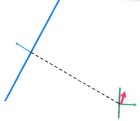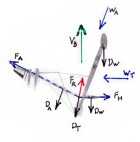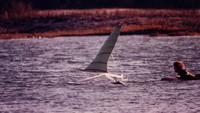High-Speed Sailing
| Vessel Name: | Sailien |
| Vessel Make/Model: | Experimental/custom |
28 September 2013
The America’s Cup
I watched, with interest, the videos of the 34th America’s Cup. At last we have fast sailboats engaged in a competition that is fun to watch. The virtual images (such as course boundaries, distance grid lines, separation between boats, etc.) overlaid on the real images really helps to keep the race [...]
31 August 2013
100 Knots for Hydroptere?
The latest news from Hydroptere is that they have plans for a 100 knot sailboat. This was posted on 26 Aug 2013, so look for that date at this address. http://hydroptere.com/en/the-news/last-news/
17 November 2012
Aptly named Sailrocket, blasts off!
While yet to be ratified, Sailrocket posted an average speed over 500 meters of 59 knots. I will not be surprised if they increase their record into the 60 knot range during this record attempt.
02 January 2012
More drag for VSR2?
I want to start by pointing out that the whole VSR2 team has done a stellar job and has demonstrated conclusively that the forces that drive a sailboat can be aligned for roll stability without using ballast and without using any down-force. (Trifoiler achieved roll stability by using down-force, but [...]
18 December 2011
My analysis of Sailrocket
I copied a diagram of VSR2 (wing doesn’t show well) and added in the major force arrows that apply. Be aware that these arrows are not correct in terms of scale (length) and some of their locations are guesses, however I believe I’m correct enough for us to learn something about what VSR2 has been [...]
23 October 2011
60 is within reach, what’s next?
I have been watching Sailrocket’s progress with great interest and there’s no question they have a winner. I fully expect to see them reach 60kt in the near future. Sailrocket has now demonstrated what I first learned with my models and again with my full-sized prototypes, that if you get the forces [...]
Windsurf speed boards
From these comments here's my take: I had been watching a windsurf speed run on You-Tube and I observed a lot of twist in the sail. It was obvious that a major part of the sail was not producing useful driving force and Mark R's. comment explains what the problem is. This is quite similar to the problem that an airplane has; at low speed they need lots of wing area and at high speed they need minimal area to lessen drag. Some of the solutions for aircraft include high-lift devices (flaps, etc.) which are deployed for low-speed lift and retracted for less drag at speed.
It may be that windsurfers will be forced to develop a variable area sail or wing in order to advance. Naturally this leads to complexity and will continue to nudge the windsurfers away from their simple roots and into the complex world of high-tech sail craft. Body fairings will also add complexity and weight and at some point, the windsurfers may morph into an exotic mini sailboat.
With reference to the speed-board specs that Mike M. posted, we can see that they are virtually running a large water ski. No wonder there is a problem getting it to plane at start-up. It may be a variable area board will be needed (step-hull, hydrofoil, etc). If the fin needs to be oversize for start-up, it might be useful to retract it part way for the run. Possibly a pedal under the sailors rear foot could ratchet it up. I would also explore using winglets or tip plates to minimize induced drag from the fin tip. (I've been using circular tip plates on my surfboard fins for a number of years.)
The reported rail profile is sharp at the rear; I assume that means that the rail is not so sharp (more rounded) further forward. (?) From my own experience with surfboards, I noticed that if the rail is rounded at any point which contacts the water, it will add drag. I first started making surfboards with hard edges extending all the way around the board in 1968; the drag decreased and the speed increased dramatically.
I believe many people think that water flow on a surfboard requires a smooth, rounded entry with a sharp trailing edge release and that a sharp edge forward will catch (dig in). This is not correct; a planing surfboard moves over the water putting pressure on the water. The pressure is from the weight of the surfer plus the weight of the surfboard. The water, being a fluid flows away from the higher pressure. Note that the water is not moving before the board touches it, but once the board moves over the water, it pressurizes it and the water starts flowing. The water flows away from the pressure point in all directions; yes it flows to both sides and even forward. Naturally we "run-over" the forward moving water, but slower planing craft actually have a visible wave or spray pushed forward. Those of you familiar with wing dynamics know that air-flow on a wing isn't straight front to rear either; there is a span wise flow that causes some air to spill off the wing tip from the higher pressure underside to the lower pressure upper side causing the wing tip vortex.
If the bottom of the surfboard is other than flat (from side to side) it may be creating extra drag. The way you want to visualize this is that whenever the surfboard moves the water, it puts energy into the water which is robbed from the surfboard's motion in the form of drag. A concave that traps air can reduce drag by lifting the board partly off the water, but otherwise a concave that the water flows through will probably increase drag since the water will be moved around as the board passes.
Bob
About & Links
- Bob's Surfing Blog
- Bob's Website
- Greenbird (Windjet)
- l'Hydroptere
- Le Projet Dared
- Macquarie Speed Sailing Team
- Monofoil Sailing
- Mountain Goat STOL
- Mr Smith's Amazing Sailboats
- Patent Office (Search)
- Radboat
- Sailien Prototypes (early), Delta, etc.
- Sailien Video
- Sailien Website
- The Basics of Surfboard Design
- The Basics of Surfboard Design en Espanol
- The Swedish Speed-Sailing Challenge
- Trifoiler
- Vestas Sailrocket
- Windjet Project
- WSSRC


